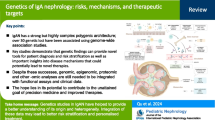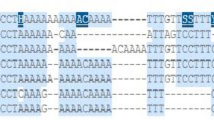Abstract
An association study between VDR gene polymorphisms and nephrolithiasis was conducted in different populations, but it is not yet known whether the association exists in the Han Chinese population. Here, we genotyped three SNPs (rs731236, rs7975232 and rs10735810) in the promoter region of the VDR gene by iMLDR genotyping assays in a large case–control cohort. The results demonstrated that there was no association found between the three SNPs (rs731236, rs7975232 and rs10735810) in the VDR gene and nephrolithiasis, whether in allele or genotype distribution. However, SNP rs10735810 was correlated with the level of serum calcium in control groups, but not in patient groups. In conclusion, considering the large sample size, we believe that the SNP rs10735810 allele A in the VDR gene promoter region may influence the level of serum calcium, but not influence the formation of nephrolithiasis in a Han Chinese population.

Similar content being viewed by others
References
Zeng Q, He Y (2013) Age-specific prevalence of kidney stones in Chinese urban inhabitants[J]. Urolithiasis 41(1):91–93
Stechman MJ, Loh NY, Thakker RV (2007) Genetics of hypercalciuric nephrolithiasis: renal stone disease[J]. Ann N Y Acad Sci 1116:461–484. https://doi.org/10.1196/annals.1402.030
Devuyst O, Pirson Y (2007) Genetics of hypercalciuric stone forming diseases[J]. Kidney Int 72(9):1065–1072. https://doi.org/10.1038/sj.ki.5002441
Halbritter J, Baum M, Hynes AM (2015) et al. Fourteen monogenic genes account for 15% of nephrolithiasis/nephrocalcinosis[J]. J Am Soc Nephrol 26(3):543–551. https://doi.org/10.1681/asn.2014040388
Arcidiacono T, Mingione A, Macrina L et al (2014) Idiopathic calcium nephrolithiasis: a review of pathogenic mechanisms in the light of genetic studies[J]. Am J Nephrol 40(6):499–506
Evan AP, Worcester EM, Coe FL et al (2015) Mechanisms of human kidney stone formation[J]. Urolithiasis 43(1):19–32
Frick KK, Asplin JR, Culbertson CD et al (2014) Persistence of 1, 25D-induced hypercalciuria in alendronate-treated genetic hypercalciuric stone-forming rats fed a low-calcium diet[J]. Am J Physiol Renal Physiol 306(9):F1081-F1087
Jacobs TP, Kaufman M, Jones G et al (2014) A lifetime of hypercalcemia and hypercalciuria, finally explained[J]. J Clin Endocrinol Metab 99(3):708–712
Dampf Stone A, Batie SF, Sabir MS et al (2015) Resveratrol potentiates vitamin D and nuclear receptor signaling[J]. J Cell Biochem 116(6):1130–1143
Landry C, Ruppe M, Grubbs E (2011) Vitamin D receptors and parathyroid glands[J]. Endocrine Pract 17(Supplement 1):63–68
Scott P, Ouimet D, Valiquette L et al (1999) Suggestive evidence for a susceptibility gene near the vitamin D receptor locus in idiopathic calcium stone formation[J]. J Am Soc Nephrol 10(5):1007–1013
Guha M, Bankura B, Ghosh S et al (2015) Polymorphisms in CaSR and CLDN14 genes associated with increased risk of kidney stone disease in patients from the eastern part of India[J]. PLoS One 10(6):e0130790. https://doi.org/10.1371/journal.pone.0130790
Cakir OO, Yilmaz A, Demir E et al (2016) Association of the BsmI, ApaI, TaqI, Tru9I and FokI polymorphisms of the vitamin D receptor gene with nephrolithiasis in the Turkish Population[J]. Urol J 13(1):2509–2518
Rendina D, De Filippo G, Gianfrancesco F et al (2016) Evidence for epistatic interaction between VDR and SLC13A2 genes in the pathogenesis of hypocitraturia in recurrent calcium oxalate stone formers[J]. J Nephrol. https://doi.org/10.1007/s40620-016-0348-8
Ozkaya O, Soylemezoglu O, Misirlioglu M et al (2003) Polymorphisms in the vitamin D receptor gene and the risk of calcium nephrolithiasis in children[J]. Eur Urol 44(1):150–154
Subasi B, Gokce I, Delil K et al (2015) Vitamin D receptor gene polymorphisms in children with kidney stone disease[J]. Pediatr Nephrol 30(9):1705
Musonda P, Paddy Farrington C, Whitaker HJ (2006) Sample sizes for self-controlled case series studies[J]. Stat Med 25(15):2618–2631
Purcell S, Neale B, Todd-Brown K et al (2007) PLINK: a tool set for whole-genome association and population-based linkage analyses[J]. Am J Hum Genet 81(3):559–575
Rendina D, Mossetti G, Viceconti R et al (2004) Association between vitamin D receptor gene polymorphisms and fasting idiopathic hypercalciuria in recurrent stone-forming patients[J]. Urology 64(4):833–838. https://doi.org/10.1016/j.urology.2004.05.013
Mossetti G, Rendina D, Viceconti R et al (2004) The relationship of 3′ vitamin D receptor haplotypes to urinary supersaturation of calcium oxalate salts and to age at onset and familial prevalence of nephrolithiasis[J]. Nephrol Dial Transplant 19(9):2259–2265. https://doi.org/10.1093/ndt/gfh273
Mittal RD, Mishra DK, Srivastava P et al (2010) Polymorphisms in the vitamin D receptor and the androgen receptor gene associated with the risk of urolithiasis[J]. Indian J Clin Biochem 25(2):119–126
Nishijima S, Sugaya K, Naito A et al (2002) Association of vitamin D receptor gene polymorphism with urolithiasis[J]. J Urol 167(5):2188–2191
Jackman SV, Kibel AS, Ovuworie CA et al (1999) Familial calcium stone disease: TaqI polymorphism and the vitamin D receptor[J]. J Endourol 13(4):313–316. https://doi.org/10.1089/end.1999.13.313
Vezzoli G, Soldati L, Proverbio MC et al (2002) Polymorphism of vitamin D receptor gene start codon in patients with calcium kidney stones[J]. J Nephrol 15(2):158–164
Mossetti G, Vuotto P, Rendina D et al (2003) Association between vitamin D receptor gene polymorphisms and tubular citrate handling in calcium nephrolithiasis[J]. J Intern Med 253(2):194–200
Funding
Current work was supported partly by the National Natural Science Foundation of China (81470989 and 81600588), and partly by the clinical research project key projects of Second Affiliated Hospital, Third Military Medical University (2015YLC06).
Author information
Authors and Affiliations
Corresponding author
Ethics declarations
Conflict of interest
The authors declare no competing financial interest.
Ethical approval
This study was conducted with the approval of the ethics committee of Third Military Medical University.
Rights and permissions
About this article
Cite this article
Yang, Z., Wang, Q., Zhong, J.F. et al. Polymorphisms of the VDR gene in patients with nephrolithiasis in a Han Chinese population. Urolithiasis 47, 149–154 (2019). https://doi.org/10.1007/s00240-018-1053-y
Received:
Accepted:
Published:
Issue Date:
DOI: https://doi.org/10.1007/s00240-018-1053-y




